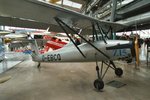Hi Trackend,
>Not being an aviator I can only guess but I would of thought something like the Piper Cub, Storch, Lysander or Stringbag would be the most forgiving of ww2 aircraft to fly having such slow stall speeds it must give the pilot much more correction time if they **** up.
The Lysander actually had some interesting characteristics that would exclude it from the "easy" categroy in my opinion ... effectiveness of elevator control depended strongly on trim, and trim took a lot of time to change. Elevator trim also depended strongly on the power condition as the propeller slipstream would make the horizontal tail more effective so that applying power for a go-around would immediately mess up your trim.
That's nothing really serious, but it meant that you had to be ahead of the aircraft at all times, and failure to pay close attention to the trim at take-off and landing might get you into difficulties.
I guess the reason for these characteristics is the intended use as artillery spotter, making stability in constant-speed level flight an important issue. The Lysander was not built for extreme STOL - unlike the Fieseler Storch, which reportedly required much pilot attention to keep it on a straight and level flight path on a hot day with some turbulence.
As usual in aviation, it's a trade-off ...
Regards,
Henning (HoHun)
>Not being an aviator I can only guess but I would of thought something like the Piper Cub, Storch, Lysander or Stringbag would be the most forgiving of ww2 aircraft to fly having such slow stall speeds it must give the pilot much more correction time if they **** up.
The Lysander actually had some interesting characteristics that would exclude it from the "easy" categroy in my opinion ... effectiveness of elevator control depended strongly on trim, and trim took a lot of time to change. Elevator trim also depended strongly on the power condition as the propeller slipstream would make the horizontal tail more effective so that applying power for a go-around would immediately mess up your trim.
That's nothing really serious, but it meant that you had to be ahead of the aircraft at all times, and failure to pay close attention to the trim at take-off and landing might get you into difficulties.
I guess the reason for these characteristics is the intended use as artillery spotter, making stability in constant-speed level flight an important issue. The Lysander was not built for extreme STOL - unlike the Fieseler Storch, which reportedly required much pilot attention to keep it on a straight and level flight path on a hot day with some turbulence.
As usual in aviation, it's a trade-off ...
Regards,
Henning (HoHun)


